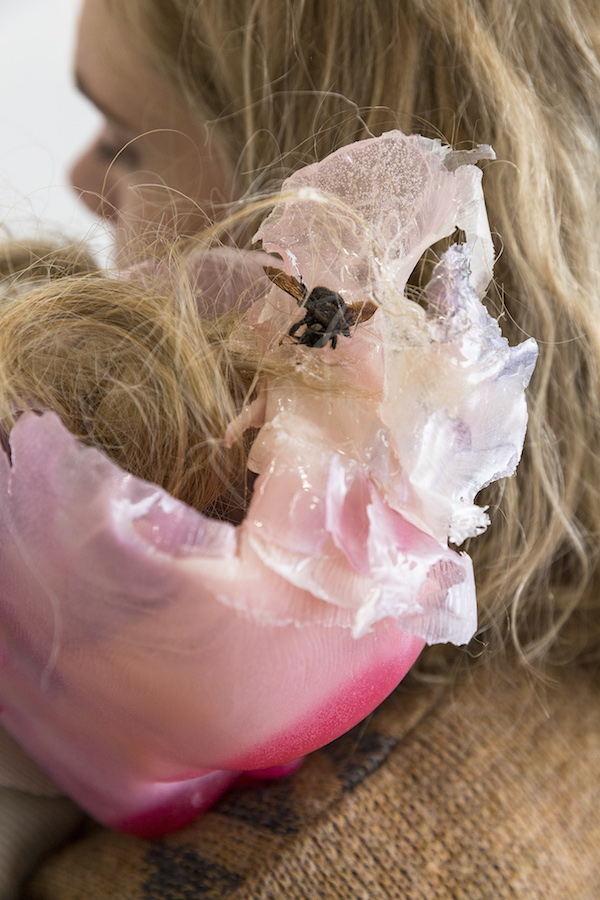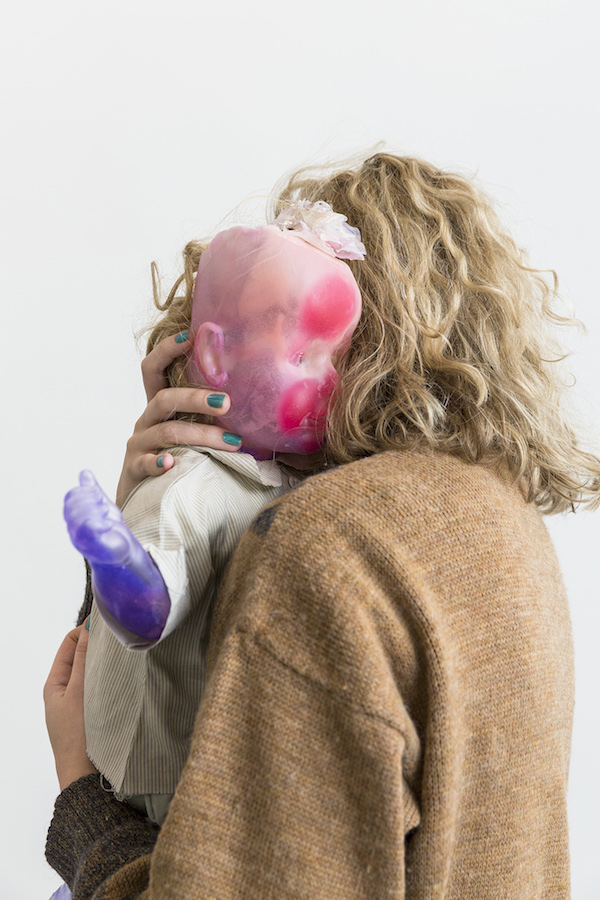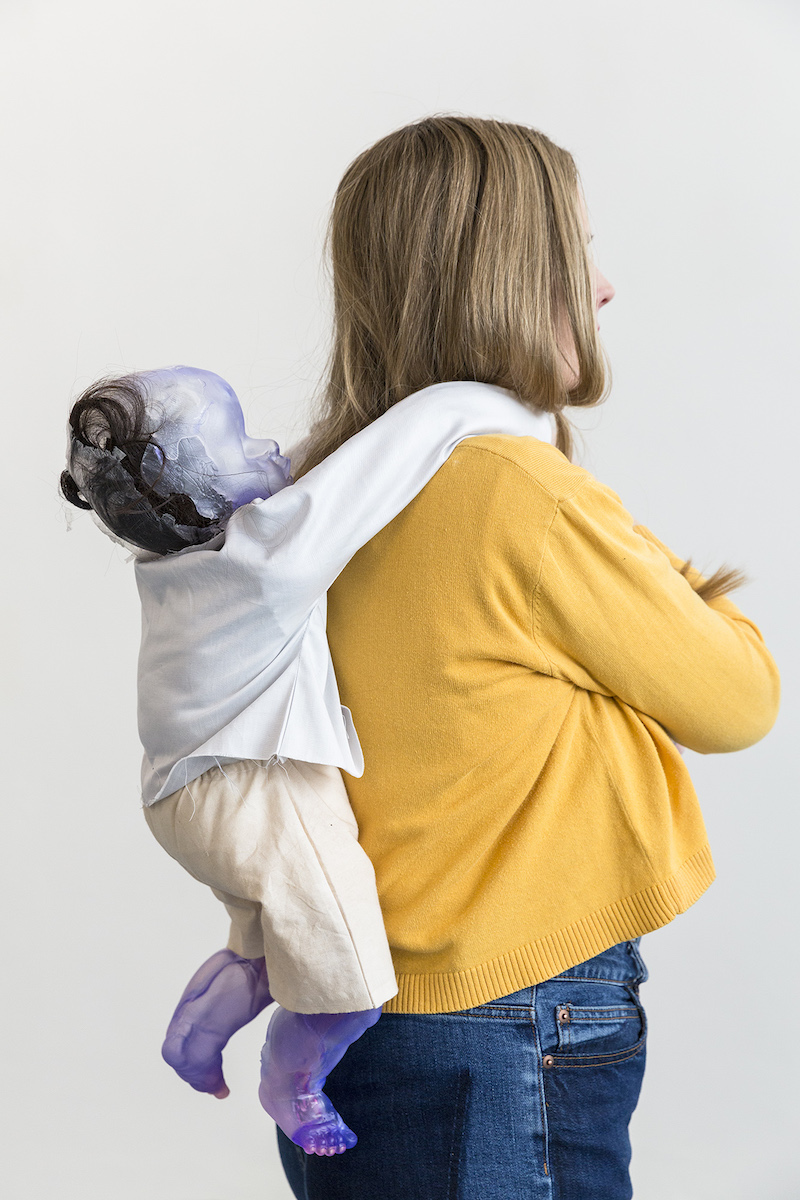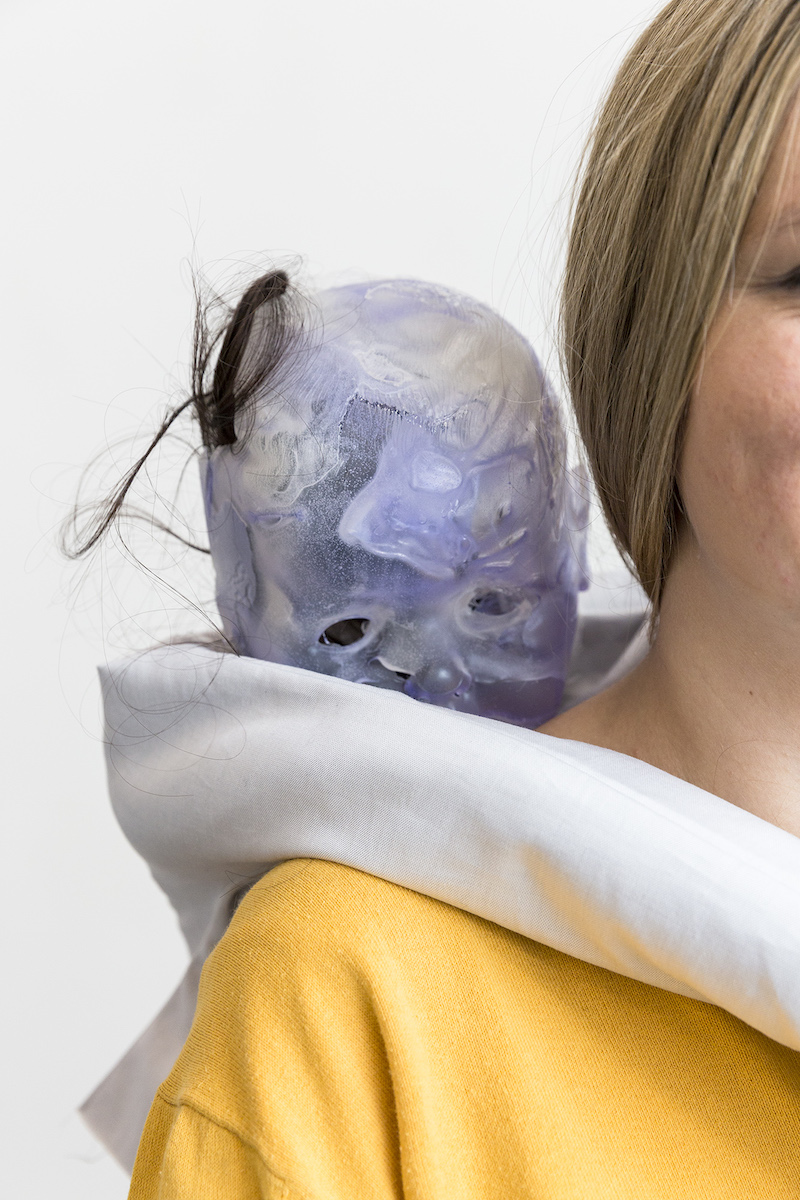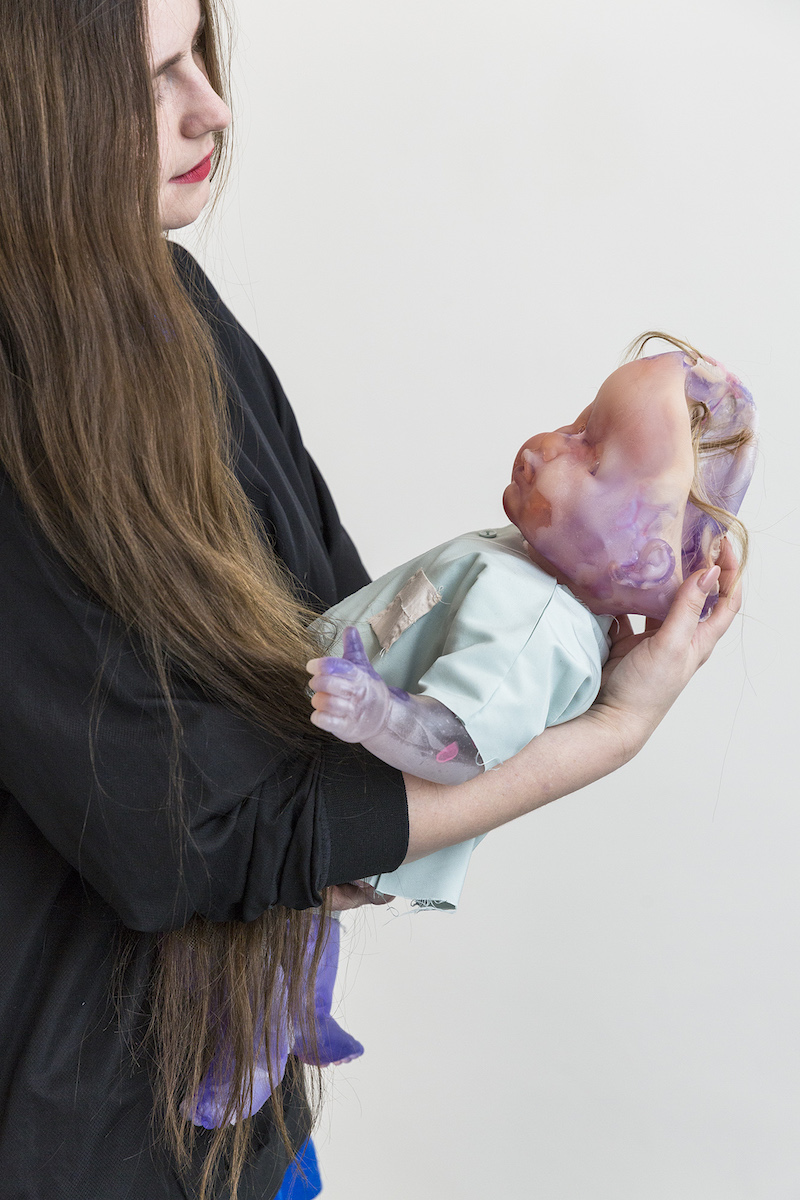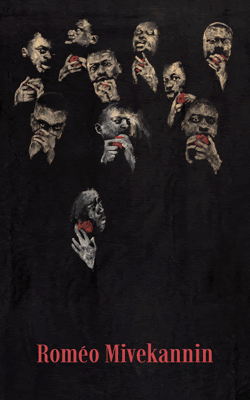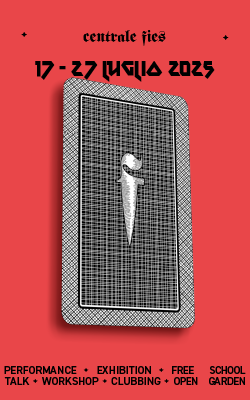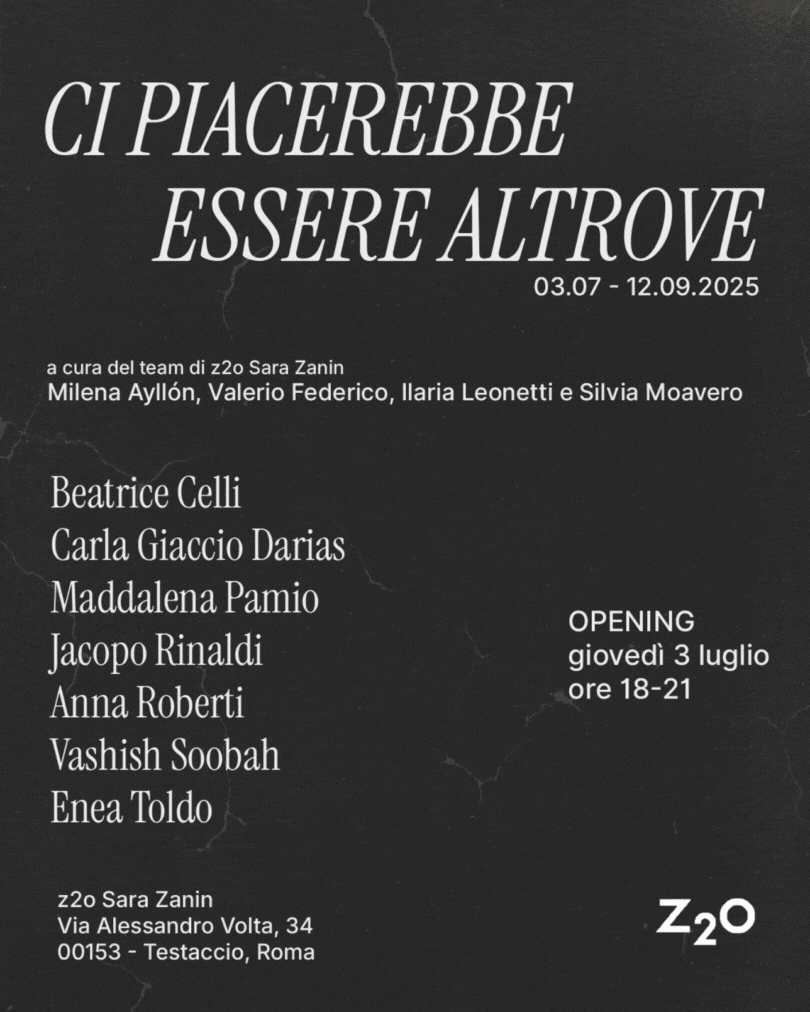Segue il testo in italiano
Prendersi cura (Taking care) a solo show by Lucia Leuci
Curated by Christina Gigliotti
18th January – 3rd March 2018
Polansky Gallery, Prague – CZ
We want to be held.
We want to be loved, nurtured, pampered.
We are not of this world, but we can learn from humans how to love, to empathize.
We too turn cold without touch. Gently take us into your arms, mind our heads, coo us to sleep.
We are the first generation, Sophia’s children.
We are perfect.Christina Gigliotti
Taking care of a new-born child, taking care of an artwork.
Giving the same attentions, the same gestures, worrying not to hurt it, not to break anything. The same craving for knowledge.
A new-born child becomes the core of the family in which it is born. Everything revolves around that tiny, precious, person in the making. It is not unlikely to hear someone say “Can I hold it?”, and the child is restlessly handed over from person to person. Attention is given to its head, we try our best not to cause it any pain and to make it feel at ease.
Shifting context, the arrival of a sculpture in a place is, as well, an event marked by many manifestations of consideration, attentions, and the concern for it not to break. Still, it’s an inanimate being, often very solid, unlike a child. These two subjects are shown the same attention, the same dedication full of prudence, accuracy, worry on the verge of reverence. This “taking care”, this overlapping of the artwork and the child, serves as the basis of my project. I’d like to highlight how much, in this exhibition, the acting character who holds the doll plays the role of co-protagonist and key actor, being herself too creator of an emotional project and analysis.
If, on the one hand, there has been a long preparation, which consisted in seams and casts, doing and undoing of the subjects, creating an ideal prequel to the action taking place inside the gallery (a preparation having itself, once more, motherly features); on the other hand these dolls become a pretext, humble props in a setting of psychological enactment to the people holding them.
Following this premise, I’ve asked the people who posed for this photo shoot, curator Christina Gigliotti among them, to describe the feelings they went through holding their doll. Photographer Jan Kolský has interpreted this emotional arrangement through a path laid down somewhere in-between personal interpretation and a close description of my work.
Lucia Leuci
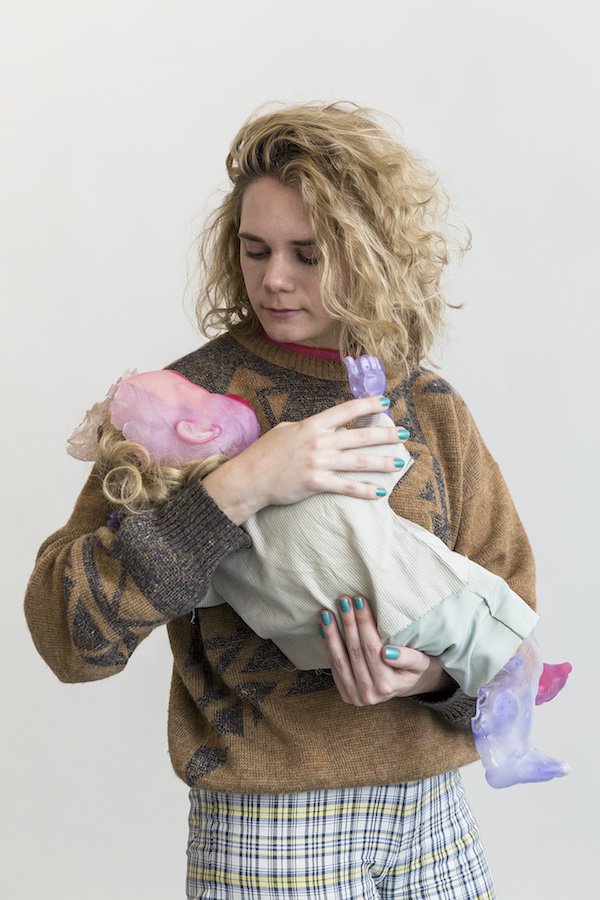
For me, the strongest moment with the sculptures was when I was unwrapping them after they were delivered from their packaging for the first time. As I was picking up and examining each of them alone in the gallery, I started to laugh at myself for feeling so unmotherly and awkward. I tried to hold the sculptures in the right positions, lifting their heads, cradling their feet, etc. The feeling of being afraid to break or drop an artwork doubled with the fact that they were shaped like deformed newborns. I tried to think of the sculptures tenderly, but it only worked if I thought of them as non-human. Considering them as kind of hybrid experimentations, it was easier to be comfortable with their form – i.e. brainless with transparent skin and disproportionate limbs. I thought of them as comparable Donna Haraway’s characters in The Camille Stories, like this first generation of children as human-animal hybrid species – that helped a lot.
Christina Gigliotti

The baby’s realistic features but colorful, lifeless body made for an interesting and enjoyably absurd interaction. I found it difficult to interact with the baby as though it were real, and my attempt to do so felt awkward and disconnected. This brought up questions about my maternal instincts, particularly when observing others interact with their baby more naturally.
Alaa El-Shaarawi

Christina told us that we shouldn’t wear black clothes. I had a fear that taking photos with a baby without half its head would seem like some kind of voodoo and that’s why we couldn’t wear black – but it wasn’t so much about the magic that scared me, more that I was going to look fat in the photos.
Bara chose the doll with the longest arms. I was hoping to have that one, because it seemed the farthest away from being a human being.
I felt superstitious about holding this rainbow baby doll while I’m in my eighth month of pregnancy. “It’s a sculpture!” I repeat. But ever since I was a child I’ve been afraid of broken or old dolls.
Tereza Štětinová

Well, during the photo shoot I was trying to come up with the good poses to show the baby’s long arms… but later, when I started to pose more naturally, I thought about last time I held a real baby.
Barbora Fastrová
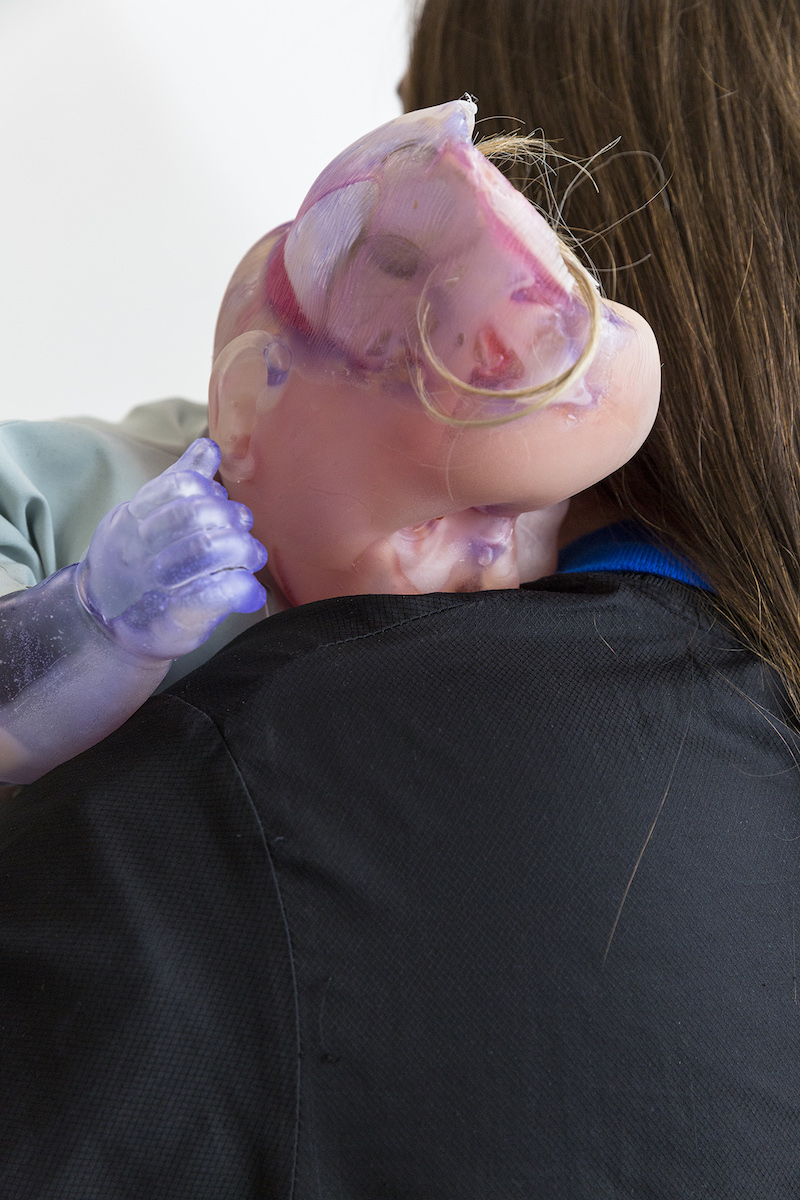
The baby’s head was leaning towards me naturally. I am not really a poser in photos, so I was scared, but I am a big hugger so I felt safe.
Nik Timková
—
Prendersi cura (Taking care) a solo show by Lucia Leuci
Curated by Christina Gigliotti
18th January – 3rd March 2018
Polansky Gallery, Prague – CZ
Prendersi cura di un bambino appena nato, prendersi cura di un’opera d’arte.
Avere le stesse attenzioni, gesti, preoccupazioni di non far male, di non rompere nulla. Lo stesso desiderio di conoscenza.
Un bambino appena nato all’interno di una famiglia diventa il fulcro della stessa. Tutto ruota intorno a quel piccolo e prezioso essere in divenire. Non è difficile ascoltare la frase “Posso prenderlo io?” ed il bambino passa senza sosta da una persona all’altra. Si presta attenzione alla sua testa, con cautela si cerca di non procurargli dolore e farlo sentire a proprio agio.
Traslando il discorso, anche l’arrivo di una scultura in un luogo è un evento segnato da molti episodi di premura, attenzione, timore di rotture. Eppure si tratta di un essere inanimato, spesso molto solido, al contrario di un bimbo. Entrambi i soggetti vengono accomunati dall’attenzione, dedizione fatta di accortezza, precisione, scrupolo al limite della riverenza. Questo “prendersi cura”, questa sovrapposizione tra l’opera d’arte ed il bambino, è alla base del mio progetto. Vorrei sottolineare che in questa mostra l’agente, colui il quale sorregge la bambola, è co-protagonista e attore focale, anch’esso artefice di un processo e di un’analisi emotiva.
Se da un lato vi è stata una lunga preparazione, fatta di cuciture e calchi, formazioni e deformazioni dei soggetti, costruendo un prequel ideale all’azione compiuta negli spazi della galleria (una preparazione che racchiude – anche in questo caso – qualcosa di materno); dall’altro le bambole diventano pretesti e semplici strumenti di uno scenario di rappresentazione psicologica per le persone che li prendono in braccio.
Facendo seguito a questa premessa, ho chiesto alle persone che hanno posato in questo set fotografico di illustrare le sensazioni provate durante il tempo in cui hanno tenuto il braccio la propria bambola, tra esse anche la curatrice Christina Gigliotti. Il fotografo Jan Kolský ha interpretato questa disposizione emotiva attraverso un percorso che investe sia di interpretazione personale che di descrizione del mio operato.
Lucia Leuci
Per me, il momento più forte con le sculture è stato il disimballaggio, appena arrivate. Mentre le prendevo e le esaminavo una ad una da sola in galleria, ho cominciato a ridere tra me per quanto sentissi poco materna ed in imbarazzo. Ho provato a tenere le sculture nella posizione giusta, sollevandone la testa, cullandone i piedi, etc. La paura di farle cadere e romperle era accentuata dal fatto che avessero le sembianze di neonati deformi. Ho provato a relazionarmici con tenerezza ma ha funzionato solo nel momento in cui ho iniziato a concepirle come non umane. Considerarle una sorta di sperimentazione ibrida ha reso più semplice trovarmi a mio agio con la loro forma – senza cervello, con la pelle trasparente e gli arti sproporzionati. Le ho trovate paragonabili ai personaggi di “The Camille Stories” di Donna Haraway, come fossero una prima generazione di ibridi umani-animali – questo mi ha aiutata molto.
Christina Gigliotti
I tratti realistici del bambino insieme al corpo multicolore e inanimato hanno creato un’interazione piacevolmente assurda. Ho trovato difficile interagire col bambino come se fosse vero, i tentativi che ho fatto a questo fine erano goffi e sconnessi. Tutto ciò mi ha portato a mettere in discussione il mio istinto materno, in particolar modo osservando le altre interagire con il loro bambino con più naturalezza.
Alaa El-Shaarawi
Christina ci ha detto di non vestirci di nero. Mi preoccupava il fatto che essere fotografata con un bambino con solo mezza testa potesse ricordare qualche rito voodoo e che quello fosse il motivo per cui non potevamo vestirci di nero – ma non era l’aspetto magico a spaventarmi quanto il fatto di uscire grassa in foto.
Bara ha scelto la bambola con le braccia lunghe. Speravo di averla io, perché sembrava quella più lontana dal ricordare qualcosa di umano. Mi sentivo superstiziosa nel tenere in braccio questa bambola arcobaleno mentre sono all’ottavo mese di gravidanza. Continuavo a ripetermi “È una scultura!”. Ma le bambole vecchie o rotte mi spaventano da quando ero piccola.
Tereza Štětinová
Ecco, durante gli scatti ho provato ad assumere le pose adatte a mostrare le lunghe braccia del bambino… dopo, quando ho iniziato a posare in maniera più naturale, ho pensato all’ultima volta che ho tenuto in braccio un vero bambino.
Barbora Fastrová
La testa del bambino era inclinata verso di me in modo naturale, non sono abituata a posare nelle foto, quindi ero spaventata, però mi piace molto abbracciare e mi sono sentita al sicuro.
Nik Timková


